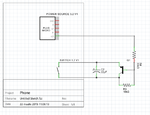pmj
Newbie level 5

I have an old mobile phone with dead battery and broken power button. I can start the phone by short circuiting the power button pads for little over two seconds. Voltage between the pads is 1,7 volts.
I would like to have some automation for that, I want put my phone back in covers and want it to start whenever I plug the power source on the wall. What components I need that short circuits the pads for 2 seconds once voltage available?
Thanks.
I would like to have some automation for that, I want put my phone back in covers and want it to start whenever I plug the power source on the wall. What components I need that short circuits the pads for 2 seconds once voltage available?
Thanks.

